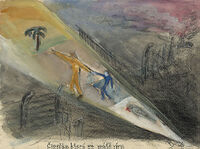Yehuda Bacon (Czechia, 1929), Holocaust survivor
Yehuda Bacon (M / Czechia, 1929), Holocaust survivor.
- KEYWORDS : <Czechia> <Theresienstadt> <Vedem> <Auschwitz> <Czech Family Camp Auschwitz> <Birkenau Boys> <Death March> <Mauthausen> <Gunskirchen>
Biography
NOTES : Yehuda Bacon was born July 28, 1929 in Ostrava, Czechia. Deported to Theresienstadt, where he performed in the opera Brundibar. He was deported to Auschwitz, where he was among the Birkenau Boys. After the war, he moved to Israel, where he became an artist.
Born in Moravska Ostrava, Czechia, to a Hasidic family. In 1942, he was deported with his family to the Theresienstadt Ghetto. In the ghetto he was housed in the youth barracks and was one of the editors of the youth magazine “Vedem”. In 1943, he was deported with his family to Auschwitz to the Czech Family Camp Auschwitz. In 1944, he was transferred to the men’s camp, where he joined the Rollwagenkommando, charged with transferring possessions, corpses and ashes. With the liquidation of Auschwitz, he was sent on a death march to Blechhammer, Mauthausen and Gunskirchen, where he was liberated on 5 May 1945. Immediately following liberation, he drew sketches of the crematoria in Auschwitz. These were subsequently submitted as evidence in the Eichmann Trial. He returned to Prague and stayed in an orphanage until he immigrated to Eretz Israel with Youth Aliya in 1946. He graduated from the Bezalel Academy of Art and continued to study in Italy, London, New York and Paris. He lives and paints in Jerusalem.
Yad Vashem
Born in Moravská Ostrava in Czechoslovakia. In 1942, he was deported with his family to Terezin, where he lived in the youth barracks and belonged to a group that produced the newspaper “Vedem” (We Are Leading). He studied with artists in the Ghetto. In 1943, Bacon and his family were deported to the “family camp” at Auschwitz. In 1944, he was transferred to the men’s camp and assigned to a labor group, which was assigned the task of gathering the murdered inmates’ belongings, and collecting the victims’ ashes for dispersal. The evacuation of Auschwitz being imminent, Bacon was sent on a death march to the Blechhammer camp, then by an arduous route to Mauthausen, and finally, to the Gunskirchen camp, where he was liberated. Immediately following his release, he drew small sketches of the crematoria and gas chambers at Auschwitz, which would later serve as testimony in Eichmann’s trial. After immigrating to the Land of Israel, he studied at the Bezalel Academy of Art, where he eventually became a faculty member.
This artwork is dedicated to the educator Pitter Přemysl, who worked to save Jewish children during and after the Holocaust and was recognized as Righteous Among the Nations in 1964. In the winter of 1944, he was a member of the Committee for Christian Aid to Jewish Children, and took upon himself to transfer Jewish child survivors to rehabilitation centers where they received medical care, nutrition and educational services. At the Chateau Štiřín near Prague, he gathered child survivors and refugees, among them the youth Yehuda Bacon who remained there from the summer of 1945 to March 1946.
In this artwork, Bacon refers to the rehabilitation process he underwent as a survivor after the war: from a major crisis of faith in people through a healing process in which Pitter Přemysl restored his sense of hope. The painting depicts the bent figure of the young Bacon being led by Přemysl through a ray of light, lifting him from the darkness and death of the camps towards light and life.
"Pitter was a wonderful person, and it was he, in my opinion, who saved us from the horror of the past. That was the first time that we gave our trust to another human. […] His good-heartedness and that of his friends changed us." (Yehuda Bacon)
